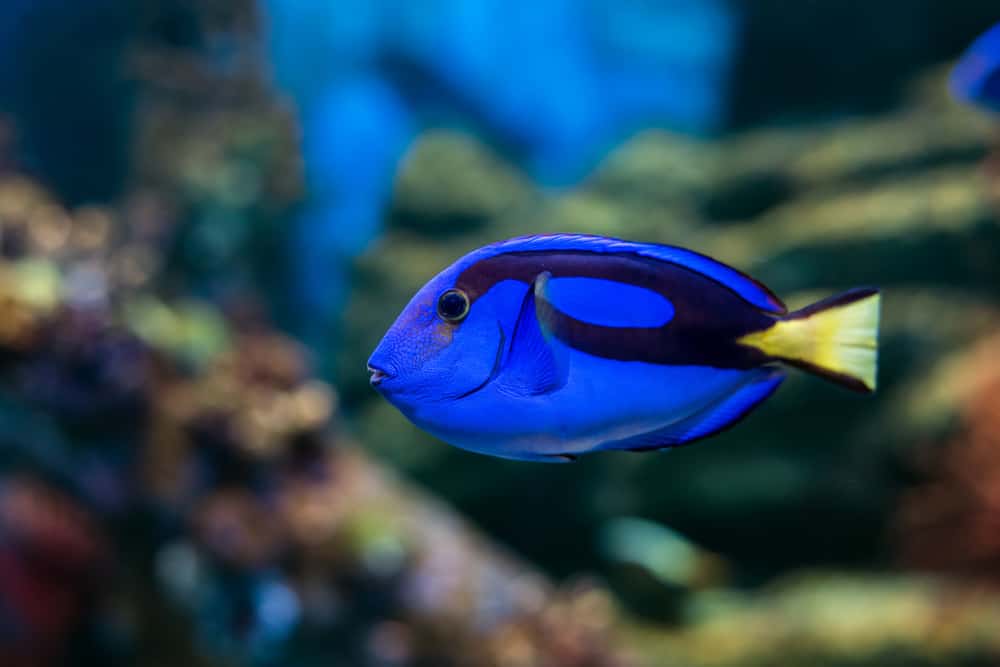
Every hobbyist will experience an algae outbreak at least once for various reasons.
The outbreak can put your aquarium’s health at serious risk.
There are several methods you can try to eliminate algae growth.
However, introducing a crew of algae grazers into your tank can be the safest option.
You’ll just have to choose the right ones.
Read the list below and find out which algae eaters can best fit your aquarium’s conditions.
10 Best Saltwater Fish That Eat Hair Algae
1. Tangs and Surgeonfish
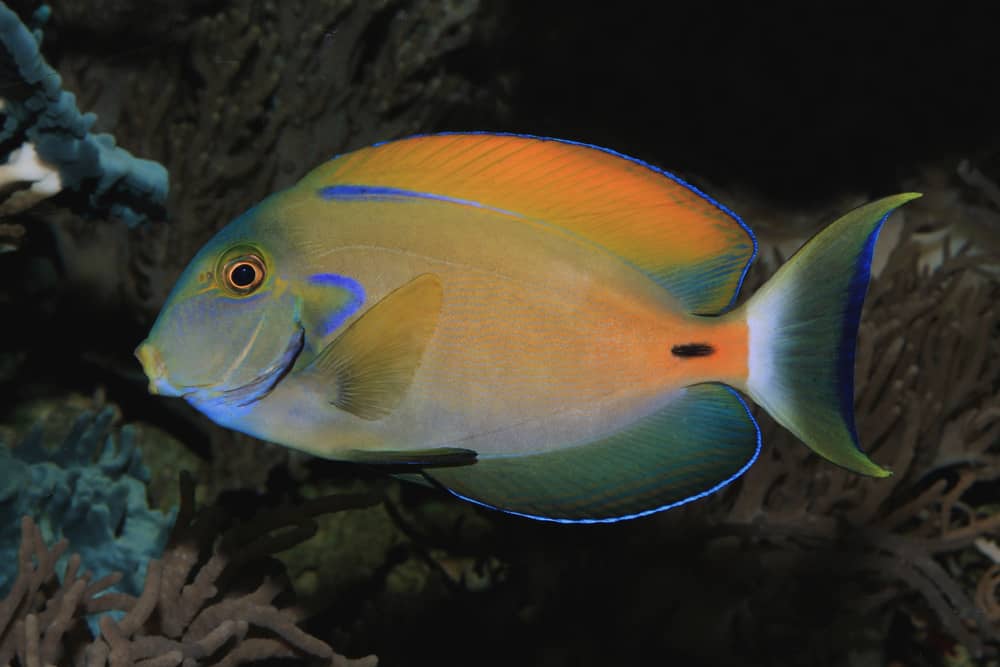
Surgeonfish and tangs are mostly herbivorous.
Green and brown algae are a big part of their diet, even in the wild,
In an aquarium, they go around cleaning algae off the rocks and tank glass.
Different species of these creatures live all around the world in tropical waters and shallow reef areas.
You can keep them in both saltwater and reef tanks, and they won’t hurt your corals.
Besides algae, they may eat plankton, small crustaceans, and invertebrates.
They can also get a taste for fish food, so it’s best to steer clear of flakes and pellets until your algae problem has gone away.
Here are the best algae grazers in this family:
- Kole Tang: Kole tang, also known as the yellow-eye tang, is an excellent choice for hobbyists with medium-sized tanks since they grow up to seven inches. This species is fond of film, hair, and macroalgae. They’re less aggressive than other members of their family. Even so, it’s best not to house them with the same species to prevent territorial behavior unless you have a large enough aquarium.
- Chevron Tang: The Chevron tang, or Hawaiian Bristletooth tang, has it all! Not only do they clear your tank of algae, but they’re also extremely attractive as juveniles. Chevron tangs are bright orange with violet markings on their fins and bodies when they’re young, making them expensive fish. As they mature, they turn olive-brown, and they can grow up to 10 inches. Chevron tangs use their bristle-like teeth to eat green hair algae, microalgae, and brown diatom algae.
- Red Sea Sailfin Tang: If you’re dealing with tough, troublesome algae like hair algae, filamentous algae, or bubble algae, these guys can help. They need a giant aquarium to grow up to 16 inches while they gobble up anything green.
- Yellow Tang: Hobbyists commonly keep yellow tangs in their saltwater tanks. These fish are active algae eaters, attractive, and affordable. They reach eight inches when fully grown. Although they get along with many fish varieties, you shouldn’t put two yellow tangs in a small aquarium, given their aggressive behavior. After they clear your tank of algae, you can feed them with seaweed, boiled vegetables, and herbivorous fish food. The only downside to yellow tangs is that they’ll graze on corals and damage them.
- Other tangs: Some other reliable algae grazers in this family include the Hippo Tang, Clown Surgeonfish, Blonde Naso Tang, Pacific Blue Tang, Purple Tang, Convict Tang, Orange Shoulder Tang, and Powder Brown Tang.
2. Blennies
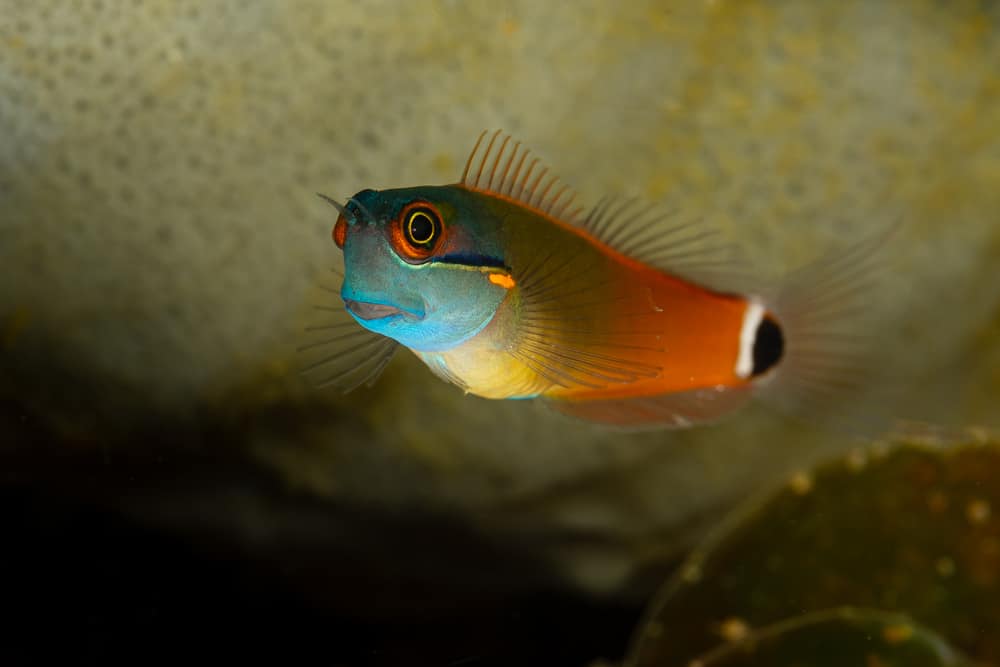
Blennies are herbivorous fish that don’t grow as big as tangs, making them suitable for smaller tanks.
Among the more than 350 varieties, only a few blenny types are great algae eaters.
They can wipe off algae from the aquarium glass, rocks, and other surfaces.
- Lawnmower Blenny: The Rock Skipper, Jeweled Blenny, or Lawnmower Blenny does a great job of eating algae with its comb-like teeth. After a while, you may even have to feed them with algae seaweed or nori to keep them from starving. They grow up to five inches, and they’re relatively peaceful creatures. However, they can get a bit feisty and aggressive towards similar species and other algae grazers. The Lawnmower Blenny isn’t a reef-safe species, as it can nip at some corals.
- Highfin Blenny: The Highfin blenny grows up to five inches and is a significant algae grazer. However, despite what you might think, it’s not a great choice for small tanks. The Highfin Blenny is aggressive and famous for fin nipping. It has no tolerance for competition, especially from herbivorous fish and other Highfin blennies. It’s best to keep them in a large aquarium, so they cause less stress for their tankmates.
- Combtooth Blenny: Combtooth Blennies are a rare species, but if you manage to get one in your tank, your algae problem will fade away. They have 100 teeth embedded in their lips, making it easy for them to scrape off microalgae and hair algae off rocks and glass. They’re also highly territorial.
- Tail Spot Blenny: Tail Spot Blennies have all the algae-eating characteristics of a Lawnmower, with the additional feature that they’re more peaceful and colorful. They’re fairly small, only growing up to three inches. They have great personalities and won’t get aggressive towards tankmates. During the day, they swim around eating film and hair algae.
- Bicolor Blenny: Bicolor Blennies are popular among fish keepers for their attractive markings, low cost, and algae-eating characteristics. They grow up to four inches and have an outgoing personality. You can keep males and females together without any problem, but two males from the same species can get territorial. You can say they’re reef safe, but use caution because there have been some rare reports of Bicolor Blennies developing a taste for corals.
- Other Blennies: Two Spot Blenny, Short-bodied Blenny, Seaweed Blenny, Marbled Blenny, Linear Blenny, and Starry Blenny are other algae-consuming varieties.
3. Rabbitfish
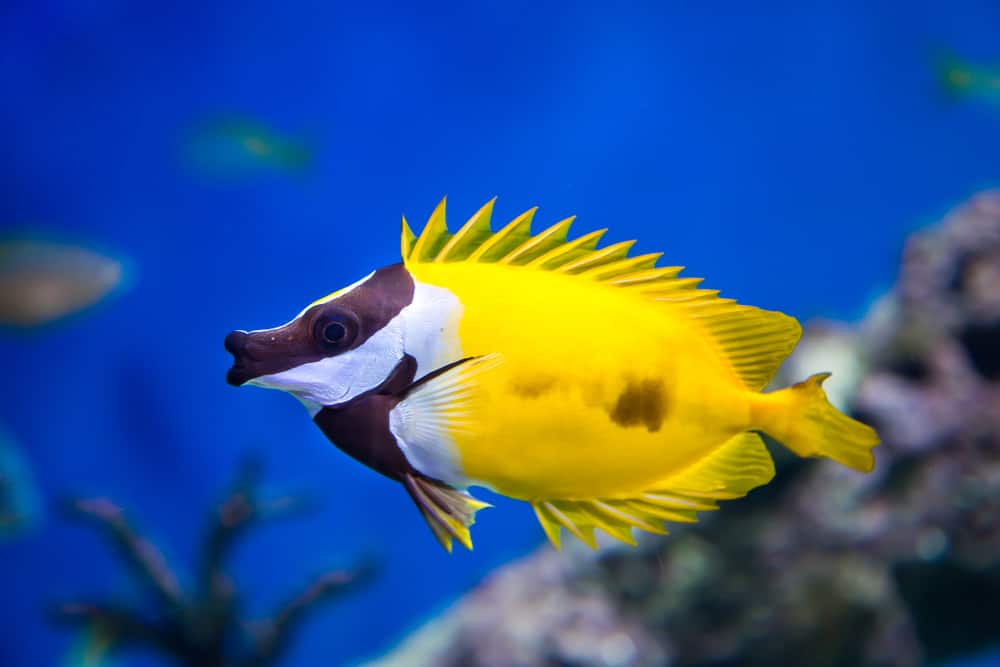
Rabbitfish are closely related to tangs.
Even though they’re omnivorous, they require a considerable amount of green vegetation in their diet, and they fulfill their need by grazing on hair algae.
These interesting creatures will hide and lose their color when the sun sets every day.
They regain their color and start browsing for algae in the morning.
Be careful with their fin spines because they’re venomous and can cause a painful sting.
Of the three or four rabbitfish varieties that find their way to the market, these two are great algae consumers:
- Foxface Rabbitfish: The Foxface rabbitfish can get rid of the algae in your tank very fast. They happily eat hair, algae, and even macroalgae. The Fox Face is a relatively hardy fish and can resist bacterial infections and ich. They grow up to eight inches pretty fast, so they will need a large tank to stay healthy. They get along with most non-aggressive fish and make a great duo with a Kole tang for clearing algae. Fox Face Rabbitfish may eat corals and invertebrates.
- Scribbled Rabbitfish: The Scribbled or Two Barred Rabbitfish is a wonderful algae eater. This species grows to about four inches, making it a great addition to medium-sized tanks. They’re relatively peaceful with their tankmates and even form schools as juveniles. However, they tend to become more aggressive towards their own kind as they grow and divide into pairs. If you keep them well-fed with hair algae, bubble algae, or macroalgae, they won’t hurt the corals.
4. Angelfish
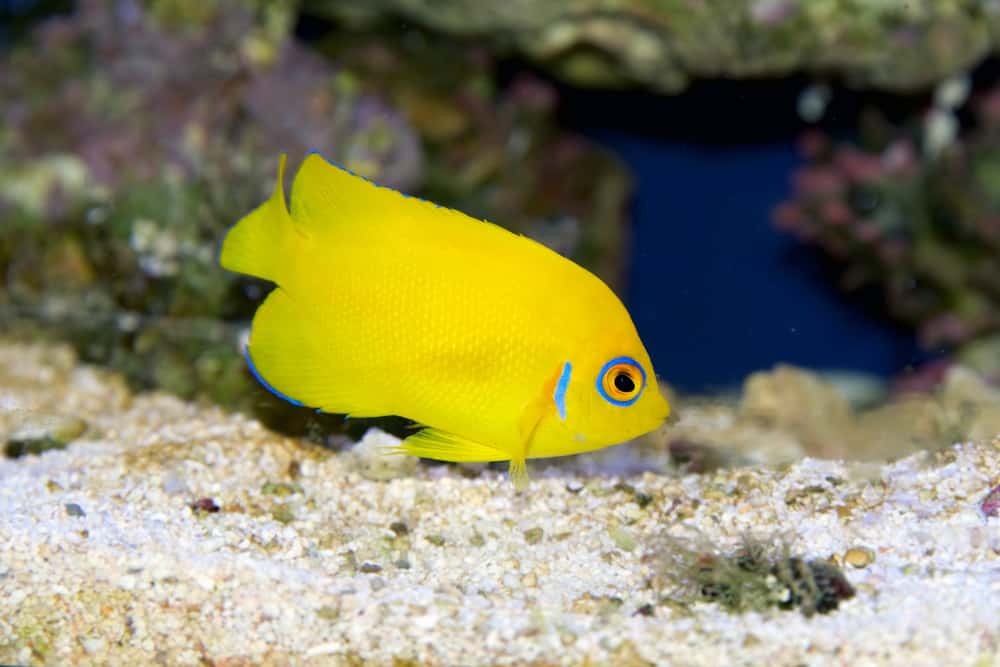
Angelfish are omnivores, and the bigger species mostly feed on plankton and invertebrates.
However, some dwarf angelfish tend to enjoy algae and detritus as a central part of their diet.
- Lemon peel Angelfish: The Lemon peel angelfish are your best choice among angels when it comes to dealing with algae. Although they eat Spirulina, Mysis, and crustaceans, they require more algae in their diet than other angelfish. Lemon peel angels have a bright yellow body and blue outlines around the eyes and fins. They grow up to five to six inches. They’re not reef-safe because they may nibble at some fleshy corals. Once they wipe out the algae in your aquarium, you can supplement their diet with seaweed.
- Flame Angelfish: Flame angels are beautiful and active algae consumers. With their vibrant orange color and black and blue markings, they’re popular creatures. They tend to grow to six inches long. Flame angelfish are peaceful among their tankmates except for similar-looking angels. Some individuals will eat certain corals, but others will leave them alone, especially if they’re well-fed.
5. Gobies
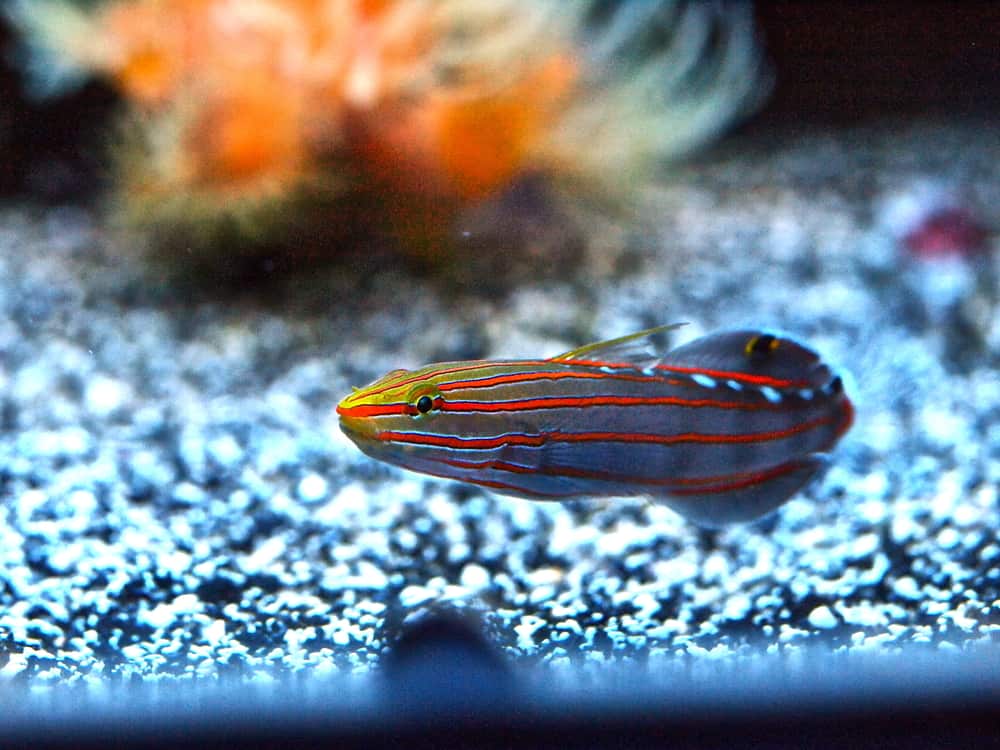
- Court Jester Goby: Court Jester Goby, also known as Orange Lined Goby or Rainford Goby, is an active swimmer that eats hair algae as its primary nutrition source. They grow to about two inches, making them a great addition to a marine or reef nano tank. They’re lovely and have multiple bright colors and markings on their bodies. Rainford Gobies are remarkably peaceful towards other fish in the aquarium. It’s best to keep them in groups because of their shy nature. Don’t house them with large and aggressive tank mates since they can scare them. Besides algae, you can feed them flakes, pellets, and frozen food.
- Hector’s Goby: Much like Court Jester Gobies, these little guys consume large amounts of algae. They’re excellent additions to any nano tank since they grow up to two inches. These active swimmers are very peaceful and love to be part of a schooling group. They go around digging in the substrate looking for detritus and worms to eat. You can feed them dry and frozen fish food along with algae.
6. Sea Hare
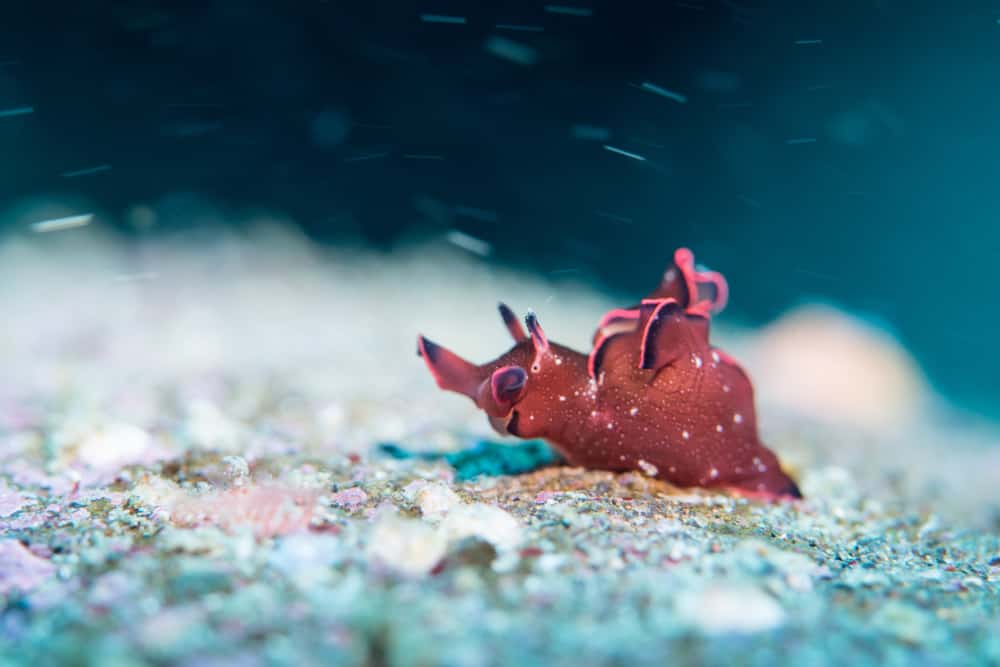
If you’re looking for a temporary guest for your aquarium that can solve your algae outbreak issue, get a Sea Hare.
They’re not attractive creatures, and some species can get huge, but they only eat algae.
They can wipe out hair algae in just a few days until there’s nothing left for them to eat.
Once that happens, you can either return them to the store or feed them with dried algae and seaweed until more algae grow.
7. Spotted Scat
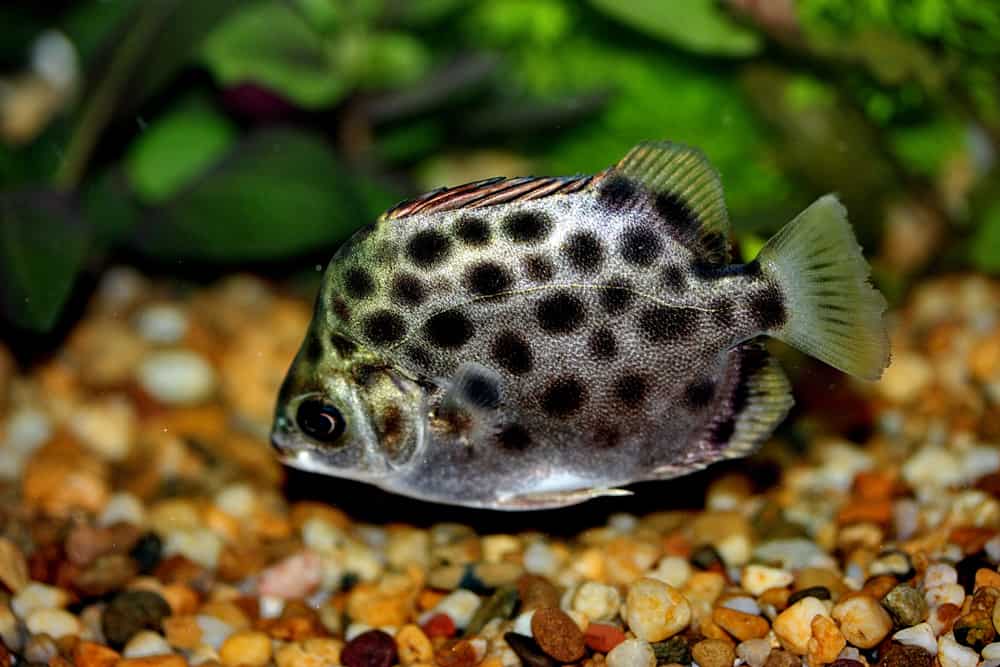
The Spotted Scat or Scatophagus Argus is a fairly active and peaceful fish.
They have small heads and rectangular bodies.
Their body is silver with a yellow or green hue, covered with dark spots.
Scatophagus means “The Eater of Feces.”
It means this type of fish is omnivorous and goes around eating algae, worms, insects, crustaceans, and even sewage.
You could say they’re very opportunistic when it comes to food sources.
They can live in freshwater as juveniles, but they won’t survive there once grown.
Mature Spotted Scats need a saltwater tank with slightly brackish water.
They grow up to 15 inches, so they need a large tank with plenty of room to swim.
Mollies, Gobies, Monos, and Archers make great tankmates for this species.
Invertebrates That Eat Hair Algae
8. Shrimps
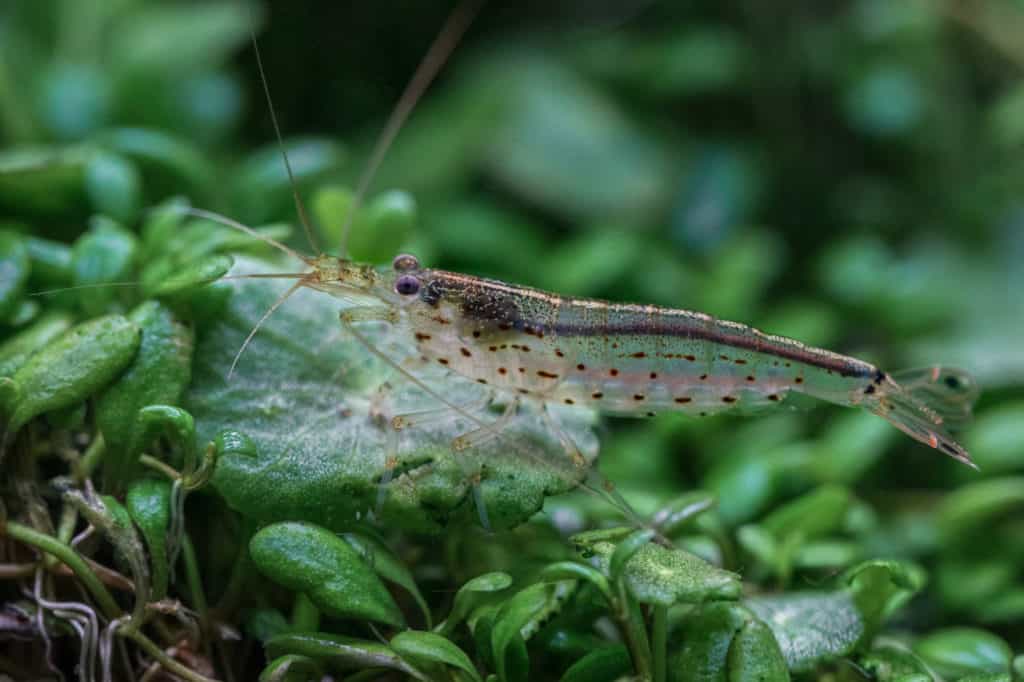
- Amano Shrimp: Amano Shrimp are well-known and traded for their hair algae-eating abilities. They can survive in various tank conditions. Amano shrimp also eat debris, detritus, and leftover fish food. They grow up to two inches and are therefore great additions to small and medium-sized aquariums. However, if you’re dealing with an algae outbreak in a large tank, these small creatures won’t be much help unless you purchase a large group. Amano shrimp won’t breed in freshwater, but as they’re relatively inexpensive, you can buy a couple of them every year or so.
- Cherry Shrimp: Compared to Amano shrimp, Cherry shrimp aren’t such voracious algae consumers. However, they can breed and multiply in various water conditions. Once they build a big enough colony, they’ll be great at preventing algae outbreaks. They grow about 1.5 inches and come in many colors. In addition to hair algae, they consume other algae types, detritus, and leftover food.
- Other shrimps: Rudolph Shrimp and Crystal Red Shrimp are also great algae consumers, but they don’t come cheap. Gammarus Shrimp, Sulawesi Shrimp, and Bamboo Shrimp can eliminate algae growth, as well.
9. Snails
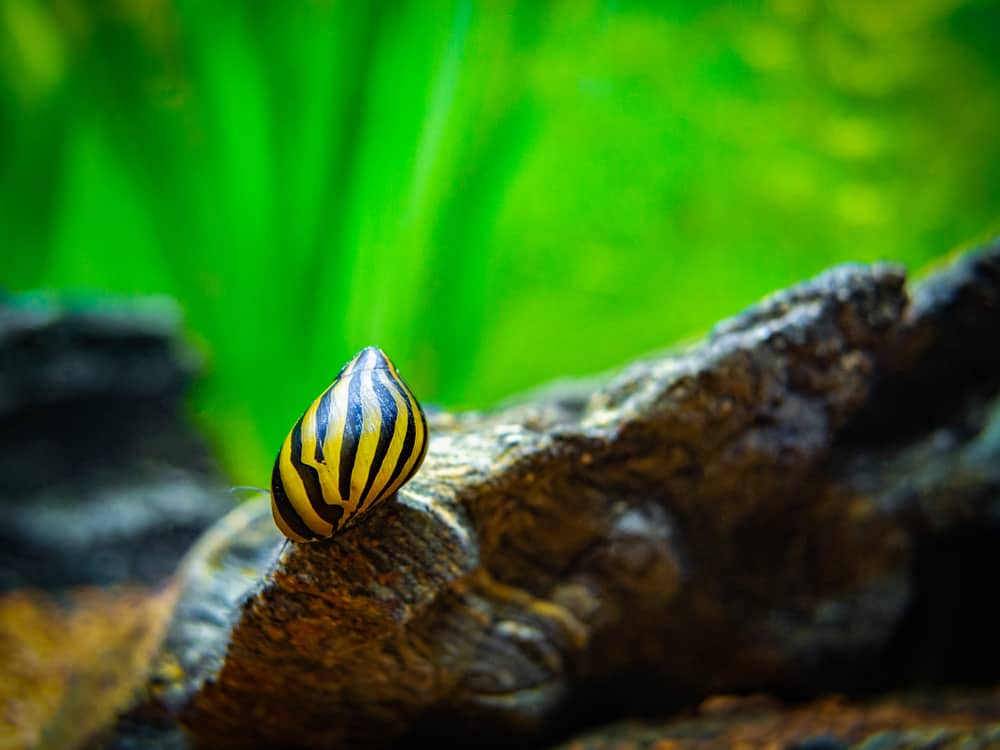
Many snail species can help you with your algae problem.
Most of them need minimal care and can survive without an additional food source.
You’ll just have to make sure other tank inhabitants won’t hurt them.
Nerite Snails are cheap and easy to find.
They scavenge and eat algae and clean the rocks and tank glass.
This snail requires slightly alkaline water to survive, with a calcium food source to develop strong shells.
It’s highly sensitive to copper and nitrate levels.
Nerite snails are the best algae grazers for a reef tank since they won’t hurt corals at all.
They lay lots of eggs, but they won’t hatch in fresh water.
A couple of Margarita snails, Chestnut Cowry Snails, and Banded Trochus Snails can be enough to get excess algae growth under control.
Zebra Turbo Snails and Mexican Turbo Snails can wipe out microalgae and diatoms quickly.
Mexican Turbos can get as big as six inches, so they’re suitable for larger tank setups.
Cerith snails consume hair and film algae.
They can fit in nano tanks since they grow to only one inch.
Malaysian Trumpet Snails, Rabbit Snails, Ramshorn Snails, and Mystery Snails are all excellent algae grazers.
10. Crabs
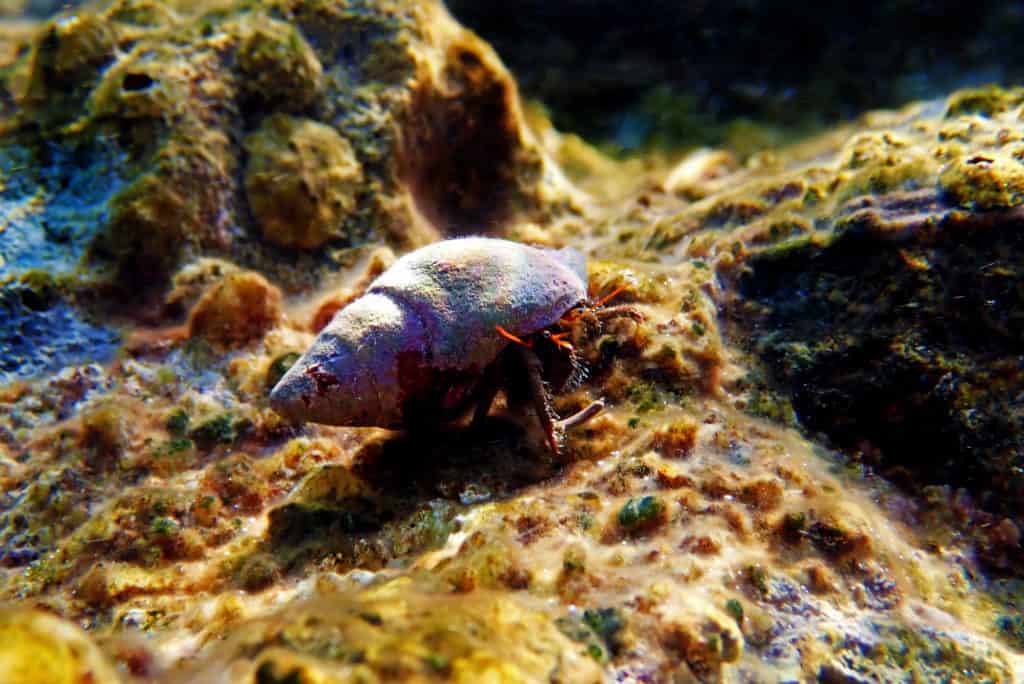
Hermit crabs and Emerald crabs can consume ample amounts of algae in saltwater and reef aquariums without hurting the corals or knocking down the decorations.
They can eat all types of algae and even leftover fish food.
Most Hermit crab species grow about one or two inches, making them suitable for nano tanks as well.
Here’s a list of Hermit Crabs you can choose from:
- Halloween Hermit Crab.
- Dwarf Blue Leg Hermit Crab.
- Dwarf Red Tip Hermit Crab.
- Dwarf Yellow Tip Hermit Crab.
- Dwarf Zebra Hermit Crab.
- Electric Blue Hermit Crab.
- Electric Orange Hermit Crab.
- Scarlet Reef Hermit Crab.
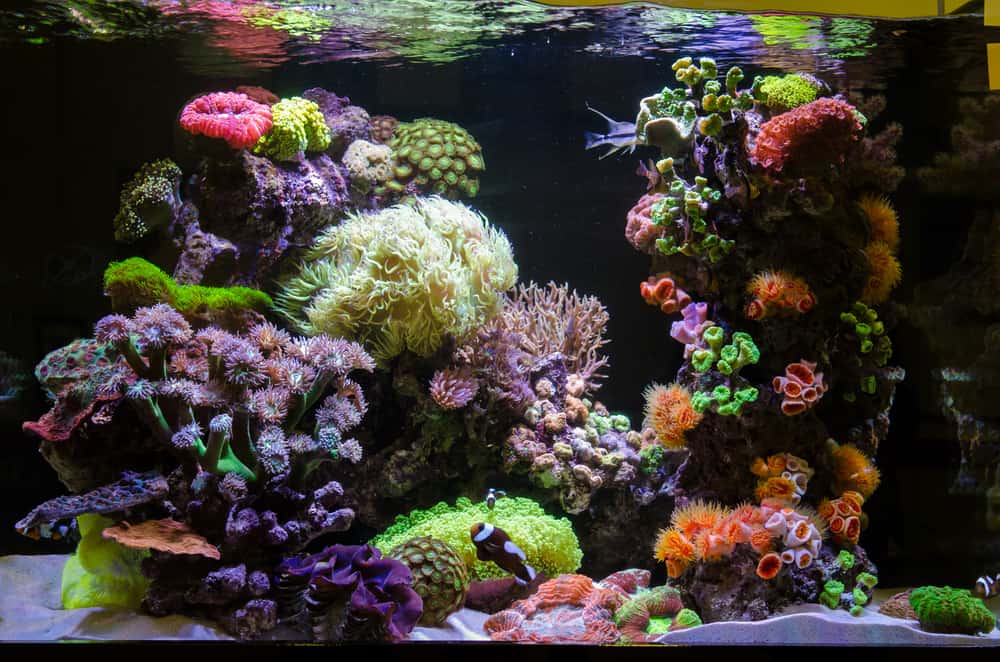
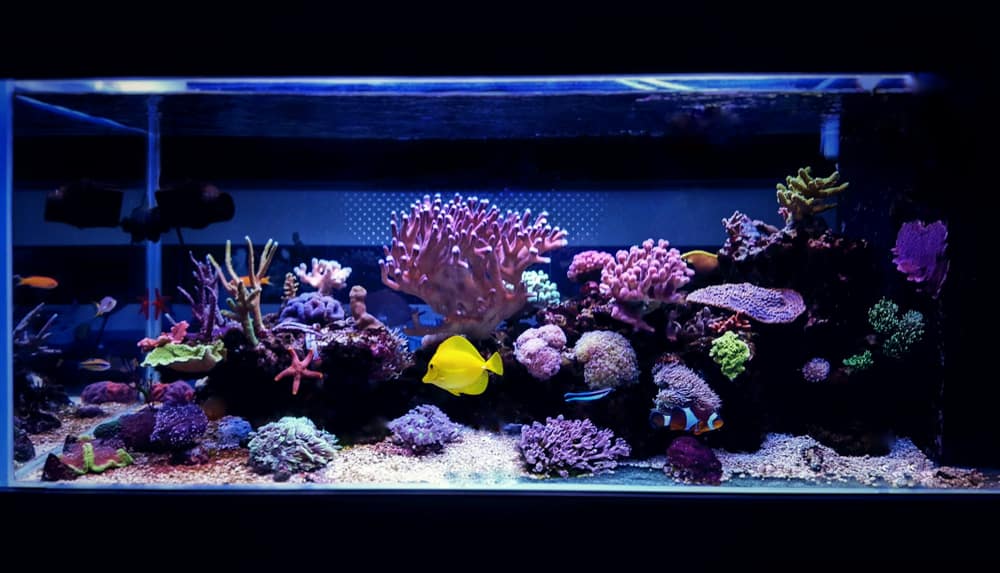
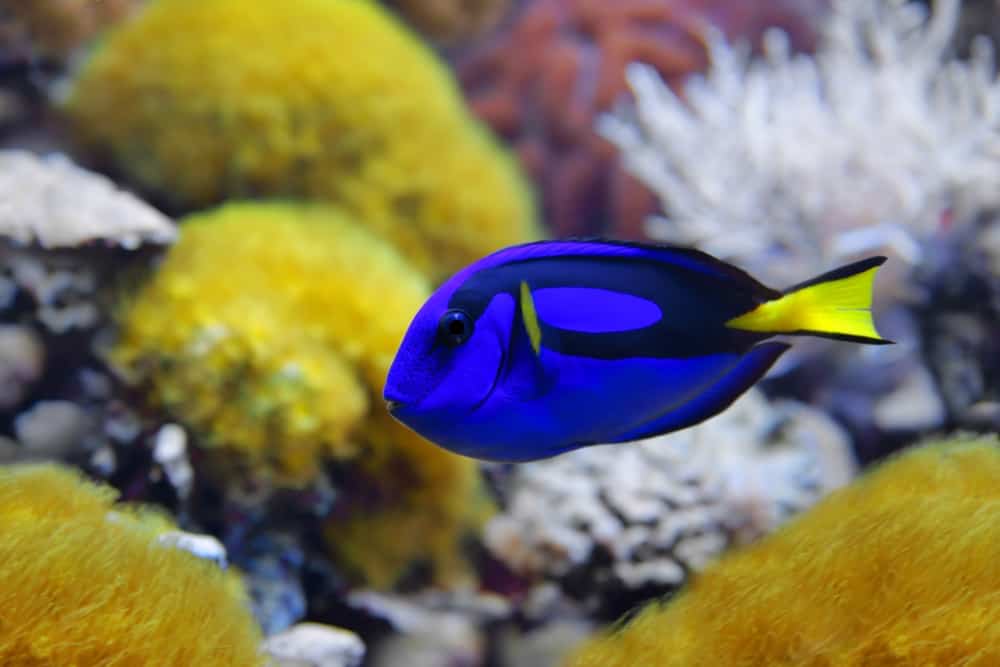
Leave a Reply
You must be logged in to post a comment.